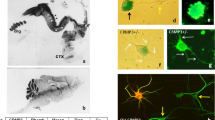Abstract
We performed a prospective analysis on 14 11q- patients to determine the relationship between the degree of cognitive impairment and relative deletion size. Seventeen measures of cognitive function were assessed. All nine patients with a deletion of at least 12.1 Mb had severe global cognitive impairment, with full-scale IQ <50, whereas all five patients with smaller deletions, ≤11.8 Mb, demonstrated mild cognitive impairment, with a full-scale IQ of 63 or higher (p < 0.001). Among these five patients, the two patients with the larger deletions (11.4, 11.8 Mb) had a selective impairment in freedom from distractability compared to the three patients with smaller deletions (≤9.1 Mb). We propose the presence of a proximal critical region that contains a gene for global cognitive function and a distal critical region that contains a gene essential for auditory attention, which may be necessary for optimizing intellectual function. The proximal critical region is 300 kb and contains three annotated genes. One of these genes, BSX, encodes a brain-specific homeobox protein that in gene-targeted mice has been shown previously to have a role in regulating locomotory behavior via BSX-expressing neurons in the hypothalamus. The distal critical region, ∼2.2 Mb, contains 18 annotated genes. One gene in this region, Neurogranin, has been demonstrated previously in mice to be critical for synapse plasticity and long-term potentiation. Taken together, our results implicate the presence of at least two loci in distal 11q that when deleted, cause global and selective deficits in neurocognitive function. These findings have important implications for genetic counseling and potential gene-specific therapies.



Similar content being viewed by others
References
Chelly J, Khelfaoui M, Francis F, Chérif B, Bienvenu T (2006) Genetics and pathophysiology of mental retardation. Eur J Hum Genet 14(6):701–713 Jun
Jacobsen P, Hauge M, Henningsen K, Hobolth N, Mikkelsen M, Philip J (1973) An (11;21) translocation in four generations with chromosome 11 abnormalities in the offspring. Hum Hered 23:568–585
Grossfeld PD, Mattina T, Lai Z, Favier R, Jones KL, Cotter F, Jones C (2004) The 11q terminal deletion disorder: a prospective study of 110 cases. Am J Med Genet A 129(1):51–61 Aug 15
UCSC genome browser (http://genome.ucsc.edu/index.html?org=Human)
Cremona M, Colombo E, Andreazzoli M, Cossu G, Broccoli V (2004) Bsx, an evolutionary conserved Brain Specific homeoboX gene expressed in the septum, epiphysis, mammillary bodies and arcuate nucleus. Gene Expr Patterns 4(1):47–51 Jan
Sakkou M, Wiedmer P, Anlag K, Hamm A, Seuntjens E, Ettwiller L, Tschöp MH, Treier M (2007) A role for brain-specific homeobox factor bsx in the control of hyperphagia and locomotory behavior. Cell Metab 5(6):450–463 Jun
Crisponi L, Deiana M, Loi A, Chiappe F, Uda M, Amati P, Bisceglia L, Zelante L, Nagaraja R, Porcu S, Ristaldi MS, Marzella R, Rocchi M, Nicolino M, Lienhardt-Roussie A, Nivelon A, Verloes A, Schlessinger D, Gasparini P, Bonneau D, Cao A, Pilia G (2001) The putative forkhead transcription factor FOXL2 is mutated in blepharophimosis/ptosis/epicanthus inversus syndrome. Nat Genet 27(2):159–166 Feb
Schmidt D, Ovitt CE, Anlag K, Fehsenfeld S, Gredsted L, Treier AC, Treier M (2004) The murine winged-helix transcription factor Foxl2 is required for granulosa cell differentiation and ovary maintenance. Development 131(4):933–942 Feb
Miyakawa T, Yared E, Pak JH, Huang FL, Huang KP, Crawley JN (2001) Neurogranin null mutant mice display performance deficits on spatial learning tasks with anxiety related components. Hippocampus 11(6):763–718
Fedorov NB, Pasinelli P, Oestreicher AB, DeGraan PN, Reymann KG (1995) Antibodies to postsynaptic PKC substrate neurogranin prevent long-term potentiation in hippocampal CA1 neurons. Eur J Neurosci 7(4):819–822 Apr 1
Krucker T, Siggins GR, McNamara RK, Lindsley KA, Dao A, Allison DW, De Lecea L, Lovenberg TW, Sutcliffe JG, Gerendasy DD (2002) Targeted disruption of RC3 reveals a calmodulin-based mechanism for regulating metaplasticity in the hippocampus. J Neurosci 22:5525–5535
Pak JH, Huang FL, Li J, Balschun D, Reymann KG, Chiang C, Westphal H, Huang KP (2000) Involvement of neurogranin in the modulation of calcium/calmodulin-dependent protein kinase II, synaptic plasticity, and spatial learning: a study with knockout mice. Proc Natl Acad Sci U S A 97(21):11232–11237 Oct 10
Huang FL, Huang KP, Wu J, Boucheron C (2006) Environmental enrichment enhances neurogranin expression and hippocampal learning and memory but fails to rescue the impairments of neurogranin null mutant mice. J Neurosci 26(23):6230–6237 Jun 7
Acknowledgments
The authors would like to thank all of the 11q- patients and their families for their participation in this study. This work was supported by PRIN 2005 and 2006 (OZ and ER), Fondazione Mariani and Fondazione CARIPLO (OZ), The Carson Foundation (CC, DI), NIH/NHLBI SCCOR P50 HL084923 (CC, DI), and grant #MO1-RR00827 for the General Clinical Research Center at UCSD from the NCRR of the NIH (PS).
Author information
Authors and Affiliations
Corresponding author
Additional information
C. D. Coldren and Z. Lai contributed equally to this work.
Electronic supplementary material
Below is the link to the electronic supplementary material.
Supplemental Table 1
Deletion breakpoints on 14 patients determined by chromosomal microarray analysis, listed in descending order of deletion size. Patient JS14 has an interstitial deletion; the other 13 patients have terminal deletions. The numbers correspond to the map position in 11q from NCBI Build 36.1. (DOC 23.5 KB)
Supplemental Table 2
Student independent group t test comparing patients with large (≥12.1 Mb) deletions to those with smaller (≤11.8 Mb) deletions. For each variable, the top row represents the patient group with the smallest deletions, and the bottom row represents the patients with the largest deletions, as well as the one patient with an interstitial deletion. Not all variables were able to be assessed on all patients. Abbreviations: See legend to Table 1. (PDF 147 KB)
Rights and permissions
About this article
Cite this article
Coldren, C.D., Lai, Z., Shragg, P. et al. Chromosomal microarray mapping suggests a role for BSX and Neurogranin in neurocognitive and behavioral defects in the 11q terminal deletion disorder (Jacobsen syndrome). Neurogenetics 10, 89–95 (2009). https://doi.org/10.1007/s10048-008-0157-x
Received:
Accepted:
Published:
Issue Date:
DOI: https://doi.org/10.1007/s10048-008-0157-x




